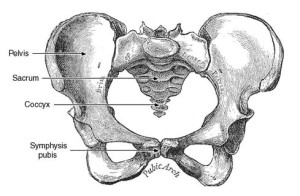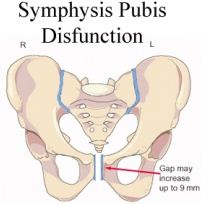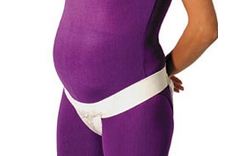Symphysis Pubis Dysfunction
Symphysis Pubis Dysfunction, also known as SPD, is a common health condition that causes extreme pain in the hips, back, groin and legs of pregnant women. This painful pregnancy symptom is a result of the aptly named hormone Relaxin. Relaxin helps to naturally make ligaments relaxed and stretchy in order for the baby to ease its way into the world. Many times, relaxin does its job too well, causing the pelvic ligaments to become too loose too soon. As a result,the pelvic joint becomes unstable, causing moderate to severe pain and instability.
 As many as 1 in 3 pregnant women may have this condition to some degree, and may not even recognize it as a condition all its own. More often than not, it is overlooked, as women do their best to endure it as another major discomfort of pregnancy.
As many as 1 in 3 pregnant women may have this condition to some degree, and may not even recognize it as a condition all its own. More often than not, it is overlooked, as women do their best to endure it as another major discomfort of pregnancy.
Pelvic girdle pain can be anything from a minor ache to a searing sensation that wraps around the back and travels down below the belly. Most women will experience this at some point or another during their pregnancy. As the ever-expanding tummy puts ever-increasing stress on the bones, joints, and muscles in the pelvis-the pain can hit at almost any point in the pregnancy, and the impact can range from minor aches and pains to debilitating and unbearable misery.
Apart from the lower abdomen and pubic pain and discomfort, SPD may also appear in the following symptoms:
- Severe pain that tends to get worse when you lift your legs for getting into bed or car.
- Difficulty to move the lower part of your body when you wake up in the morning.
- Pain that gets worse when you lie on your back.
- Reduced range of movement of the hip bones, causing difficulty walking.
- Pain shooting down your buttocks and legs (sciatica).
- A clicking sound near the pelvic area while in motion.
- Urinary incontinence (rare cases).
If you think you may be suffering from this condition, do some research and talk to your  doctor. Never just endure the pain. Many things can be done to help lessen the symptoms of SPD. Acupuncture is an increasingly popular way to alleviate all kinds of pregnancy ills, including pelvic girdle pain. Your doctor will almost always instruct you to purchase (and wear) a pelvic support girdle, aka a maternity belt with a special pelvic support built into it.
doctor. Never just endure the pain. Many things can be done to help lessen the symptoms of SPD. Acupuncture is an increasingly popular way to alleviate all kinds of pregnancy ills, including pelvic girdle pain. Your doctor will almost always instruct you to purchase (and wear) a pelvic support girdle, aka a maternity belt with a special pelvic support built into it.
V2 Supporter
While there are alternatives (albeit none that really measure up in terms of effectiveness, appearance or even cost), the increasingly popular choice for dealing with moderate-to-severe pain of this nature is a product known as a V2 Supporter, or a variation thereof. The V2 Supporter is sold as a standalone compressive therapeutic undergarment, and can also be purchased as a 2-in-1 combo support undergarment such as the Prenatal Cradle Plus V2 Support and the Hip Brace Plus V2 Supporter.
 This undergarment will provide much needed support for your belly (and relief for your pelvis). These same products are also used to treat a very common condition during pregnancy called vulvar varicosities, which is effectively vulvar or vaginal varicose veins. While more common among women who are pregnant, many women who are not pregnant and some who’ve never even been pregnant occasionally come down with this most unfortunate condition characterized by painful swelling of the vulvar region.
This undergarment will provide much needed support for your belly (and relief for your pelvis). These same products are also used to treat a very common condition during pregnancy called vulvar varicosities, which is effectively vulvar or vaginal varicose veins. While more common among women who are pregnant, many women who are not pregnant and some who’ve never even been pregnant occasionally come down with this most unfortunate condition characterized by painful swelling of the vulvar region.
Back to Symphysis Pubis Dysfunction, heating pads and ice have been known to offer significant relief. Choose the right sleeping position — lie on your side with a pillow between your knees to keep hips aligned. Do what works best for you and your body. Try doing KEGEL Exercises. Yes, our old friend can do wonders in this situation. These handy little workouts strengthen the entire pelvic floor, the muscle that stretches like a hammock across our abdomens and essentially holds all our organs up. The stronger it is, the better it holds up the growing baby and uterus and the less everything presses on those already weakened bones. If the pain is severe, ask your practitioner about pregnancy-safe pain relievers (never take any medications unless specifically okayed by your practitioner). Remember, do what makes you comfortable and what makes you feel better. Work together along with your doctor and family to make this special experience as comfortable and enjoyable as possible. More tactics to try: Sit down to get dressed, and avoid heavy lifting and pushing (which you should be doing anyway). Do your best to stay off your feet and try to be patient until the baby comes. For most moms, once the baby is born and relaxin production ceases, your ligaments (and your dance moves) will return to normal in no time.
Video: Symphysis Pubis Dysfunction

